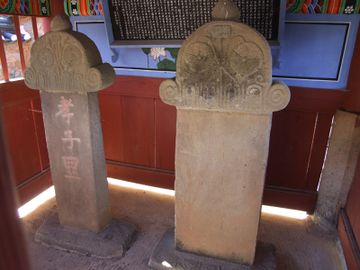합천 외토리 쌍비
| 합천 외토리 쌍비 Twin Steles in Oeto-ri, Hapcheon |
|
 합천 외토리 쌍비, 국가문화유산포털, 문화재청. |
|
| 대표명칭 | 합천 외토리 쌍비 |
|---|---|
| 영문명칭 | Twin Steles in Oeto-ri, Hapcheon |
| 한자 | 陜川 外兎里 雙碑 |
| 주소 | 경상남도 합천군 삼가면 남명로 57 (외토리) |
| 지정(등록) 종목 | 경상남도 유형문화재 제291호 |
| 지정(등록)일 | 1993년 1월 8일 |
| 분류 | 기록유산/서각류/금석각류/비 |
| 수량/면적 | 2기 |
| 웹사이트 | 합천 외토리 쌍비, 국가문화유산포털, 문화재청. |
|
|
|
해설문
국문
'외토리 쌍비'는 비각(碑閣)에 두 비석이 나란히 서 있기 때문에 붙여진 이름이다. 왼쪽의 비는 이 마을에 살던 영모재 이온(永慕齋 李榲, ?~1379)의 효행을 기리기 위해, 고려 말 이성계가 영남지방을 순시할 때 그의 효행을 듣고 왕에게 보고하여 1383년(우왕 9)에 나라에서 세운 것이다.
비석의 앞면에는 이온이 효행을 행한 마을이라는 뜻으로 ‘孝子里’라 새기고, 뒷면에는 부친상을 당해 3년간 시묘살이를 한 기록이 있다. 이 비석은 1383년에 세워졌다는 기록이 분명하게 남아있는 흔하지 않은 고려시대 효자비라는 점에서 가치가 있다.
오른쪽의 비는 풍화되어 글씨가 거의 마모되었지만, 왼쪽 비의 기록으로 미루어 볼 때 효자비로 추정된다.
원래 비신만 남아있던 것을 1686년(숙종 12) 이수(螭首)와 대석(臺石)을 새로 조성했다고 하며, 이후 세상 사람들의 귀감으로 삼기 위해 비석을 사람들의 왕래가 잦은 원동마을 앞으로 옮겨 세웠으나 일제강점기에 원래의 자리인 이곳으로 다시 옮겨왔다고 한다.
영문
Twin Steles in Oeto-ri, Hapcheon
These two steles located next to each other are called twin steles due to their resemblance in size and shape. The stele to the left was erected in 1383 during the Goryeo period (918-1392) to commemorate Yi On (?-1379), a man known for his filial piety who lived in this village. The stele to the right, however, has been damaged by erosion, so the text of the inscription became illegible, making it impossible to find out why and when the stele was erected. Each stele consists of a pedestal, body stone, and a capstone shaped like a flower.
The stele commemorating Yi On features an inscription on the front side that reads “Village of a Filial Son” and an inscription on the back which contains a record about Yi On’s filial piety as well as information about the stele itself. After his father died, Yi spent the required multi-year mourning period living in a hut next to the tomb. When the general Yi Seong-gye (later King Taejo of the Joseon dynasty, 1335-1408) visited the village and learned of Yi On’s filial piety, he reported this to King U (r. 1374-1389), who then ordered that the stele be erected. Also, according to the inscription, the stele originally consisted only of the body stone. The pedestal and capstone were added in 1686.
It is said that later, the stele was moved to the nearby Wondong Village, where more passersby could see it, but in the first half of the 20th century, it was returned to its original location.
영문 해설 내용
쌍비는 크기와 모양이 같은 2기의 비석이 나란히 서 있기 때문에 붙여진 이름이다. 왼쪽의 비는 이 마을에 살던 효자 이온(?-1379)을 기리기 위해 1383년에 세운 것이다. 오른쪽의 것은 글씨가 마모되어 언제, 어떤 목적에 의해 세워졌는지 알 수 없다. 2기 모두 받침돌, 비몸, 꽃봉오리 모양의 머릿돌로 이루어져 있다.
이온의 비 앞면에는 '효자 마을'이라는 글자가 새겨져 있고, 뒷면에 새긴 비문에는 이온의 효행과 비석을 세운 내력을 기록하였다. 이온은 부친상을 당한 뒤 묘소 근처에 움집을 짓고 삼년상을 치렀다. 고려의 장군이자 이후 조선을 건국한 이성계(1335-1408)가 이 마을을 방문했을 때, 이온의 효행을 듣고 우왕(재위 1374-1389)에게 보고하여 비석을 세우도록 했다. 또한 비문에 따르면, 원래 비몸만 있었는데 1686년에 받침돌과 머릿돌을 새로 만들었다고 한다.
이후 사람들의 왕래가 잦은 인근 원동마을 입구로 옮겨 많은 사람들이 볼 수 있도록 하였다가, 20세기 전반에 원래 자리였던 이곳으로 다시 옮겨왔다고 한다.
참고자료
- 합천 외토리 쌍비, 여행은 행복이다, 네이버 블로그 https://blog.naver.com/ohmark/221493242627 -> 답사 사진
- 외토리 쌍비 고려, 申祺丞의 伸天之路, 다음 블로그 http://blog.daum.net/sws8007/16155157 -> 비석 상세 사진